 When looking for origins, it’s sometimes good to start with the name. Since the 18th century, Trevi has been considered a corruption of the “Tre Vie” or “Trivium” in Latin, the three streets creating the perimeter around the grand fountain. It does make sense. The Piazza del Trevi is created by the intersection of via della Stamperia, via delle Muratte and Via Poli.
When looking for origins, it’s sometimes good to start with the name. Since the 18th century, Trevi has been considered a corruption of the “Tre Vie” or “Trivium” in Latin, the three streets creating the perimeter around the grand fountain. It does make sense. The Piazza del Trevi is created by the intersection of via della Stamperia, via delle Muratte and Via Poli.
This explanation has taken such strong roots that since the redistricting of the Rioni (neighborhoods) of Rome during the occupation of Napoleon in the early 19th century, the logo of the Rione di Trevi was created with three swords, representing the three streets.
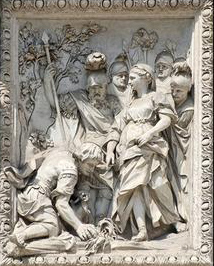 It’s a pretty strong argument except for the many historians who believe the fountain was named for the ancient Roman Virgin named Trivia, who showed Agrippa the location of the source of the water used to build an aqueduct. In 19 BC, Agrippa completed the Aqueduct and named it Aqua Virgo (Virgin) in honor of the virgin Trivia. The water fed the Baths of Agrippa, a few other places in the ancient city around the Campo Marzio. Now it terminates at the Trevi Fountain. The panel to the right is from the Trevi Fountain.
It’s a pretty strong argument except for the many historians who believe the fountain was named for the ancient Roman Virgin named Trivia, who showed Agrippa the location of the source of the water used to build an aqueduct. In 19 BC, Agrippa completed the Aqueduct and named it Aqua Virgo (Virgin) in honor of the virgin Trivia. The water fed the Baths of Agrippa, a few other places in the ancient city around the Campo Marzio. Now it terminates at the Trevi Fountain. The panel to the right is from the Trevi Fountain.
OK, so now we have two distinctly different and plausible explanations, but for historians, two explanations is never enough. Some ancient Roman scholars have pointed out that the ancient name of this part of Rome was known as Tribium or Trivium. They believe the name came from ancient district.
So there you have it, an intersection of three roads, the ancient name of the neighborhood or the Virgin who showed Agrippa the water source. It’s not even a hard decision for me. The Virgin gets my vote.
When Agrippa completed the Aqua Virgo in 19 BC there were 6 great water bridges into the city, bringing in close to 160 million gallons of water a day. By the year 226 AD, there were 11 aqueducts bringing in over 300 million gallons of water. It might seem like a lot of water but not when you consider a city of over a million people with 11 giant bath houses, over 800 private baths, 5 artificial lakes, 15 great fountains over 1000 drinking fountains and over 100 public toilets.
During the 537 Siege of Rome, in an attempt to starve the Romans into submission, King Vitiges and the Ostrogoths destroyed the all of the Aqueducts but one, the Acqua Virgo. The only reason it was saved was because most of it ran underground.
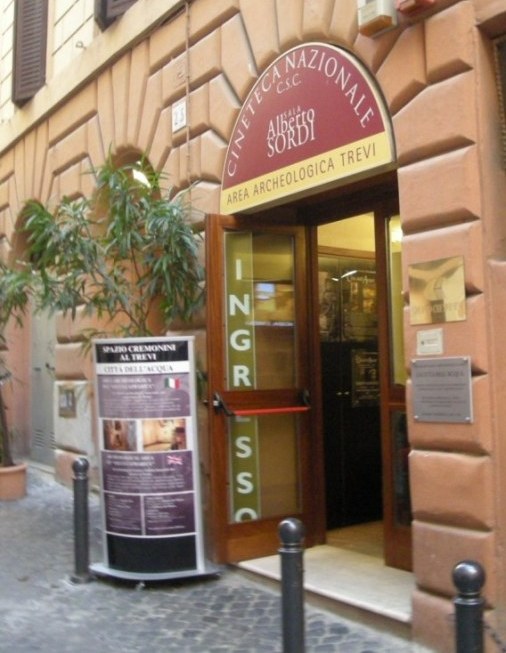 You can still see the remains of the ancient Aqua Virgo in the basement of the Cinema Trevi at Vicolo Del Puttarello 25, a 2 minute walk from the Fountain. The Cinema shows classic 1960’s Italian neorealism films but the people who work there will usually let you in to see the archeological ruins.
You can still see the remains of the ancient Aqua Virgo in the basement of the Cinema Trevi at Vicolo Del Puttarello 25, a 2 minute walk from the Fountain. The Cinema shows classic 1960’s Italian neorealism films but the people who work there will usually let you in to see the archeological ruins.
The Aqua Virgo was (barely) still in use in the 15th century when Pope Nicholas V (Parentucelli) had it repaired and renamed as the Acqua Vergine (same word, different virgin). His plans were to build a great fountain at the terminus in what is now Piazza del Trevi, and although he gave enough money for the architect, Leon Battista Alberti to build a large basin, the funding dried up and the grand fountain was put on hold, for close to 200 years.
In 1629, Pope Urban VIII (Barberini), along with his other Urban renewal projects, decided to finish the fountain. He gave the project to his favorite architect GianLorenzo Bernini, who drew up the plans and actually started work on the foundation, but when Pope Urban VIII died, so did a lot of the his building projects.
Finally, in 1730, Pope Clement XII (Corsini) decided to finish the project and held a contest for the new fountain design. Bernini died in 1680 so unfortunately he wasn’t available.
Contests were popular in the Baroque period. With so many building projects going on, the Pope was always eager to discover the next Bernini or Michelangelo.
When the new fountain was first awarded to a Florentine named Alessandro Galilei, the Roman citizens were pissed. How dare he bring in a foreigner to create a Roman fountain? Fearing an insurrection, Clement XII rescinded his award to Galilei and gave the project to an unknown Roman architect named Nichola Salvi.
Salvi was 33yrs old when he got the commission. Although he worked on several small churches, this was his first big project. It was also his last. Salvi started the fountain in 1732. He died in 1751 at age 54. The Fountain wasn’t completed until 1762. Most of the final design and architectural duties were carried out by Salvi’s assistant, Giuseppe Pannini.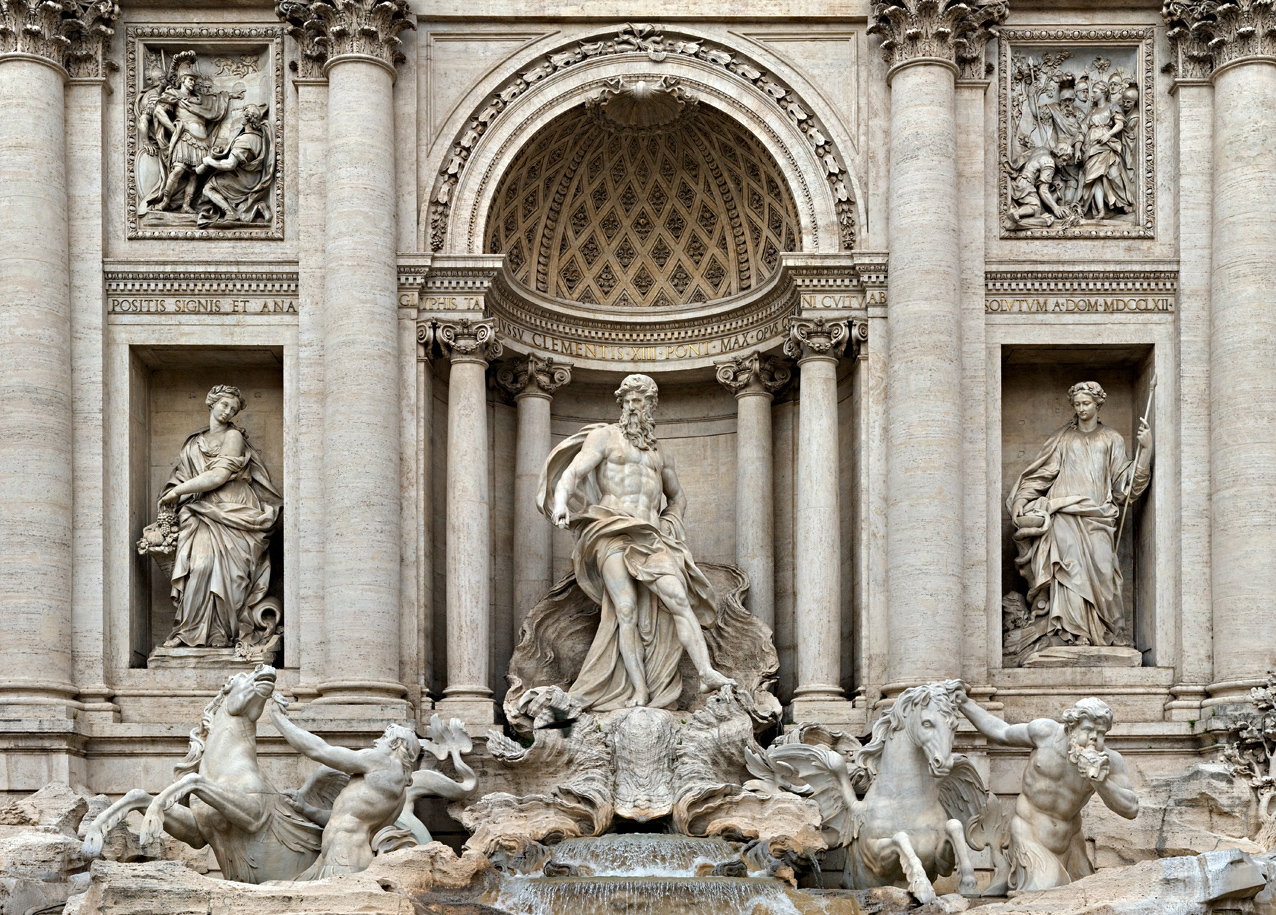
The design of the Fountain has Pietro Bracci’s great sculpture of the divine Oceanus in the center riding in on a giant clamshell, heralded by Triton (son of Poseidon.Neptune) blowing a conch shell.
In front of the Oceanus and his descendant are the two horses, one wild and one calm, representing the two attributes of the oceans. In the niches to either side of Oceanus are the allegorical images of Abundance and Salubrity (Prosperity and Health). If you look over the statues of Prosperity and Health, you can see the relief panels that tell the ancient story of the fountain origins.
Above the statue of Health (to Oceanus’ left) is the relief of Trivia showing the Romans the source of the water. Above the statue of Prosperity is the relief of Agrippa, the builder.
When you look up, you’ll notice the entire magnificence of the fountain is dedicated to the power and the glory of the Corsini Pope, Clement XII.
The Villa Poli, the Palazzo holding up the grand fountain was altered a bit during the construction to make it all seem integrated into the fountain design. Although the Villa Poli was once a private home, it’s currently owned by the Italian government and is home of the National Institute for Graphics.
There are those who say that some of Bernini’s designs from the early 1600’s were included in the project, and it does have a very Bernini feel to it, but there aren’t any known details of the original Salvi designs except for one.
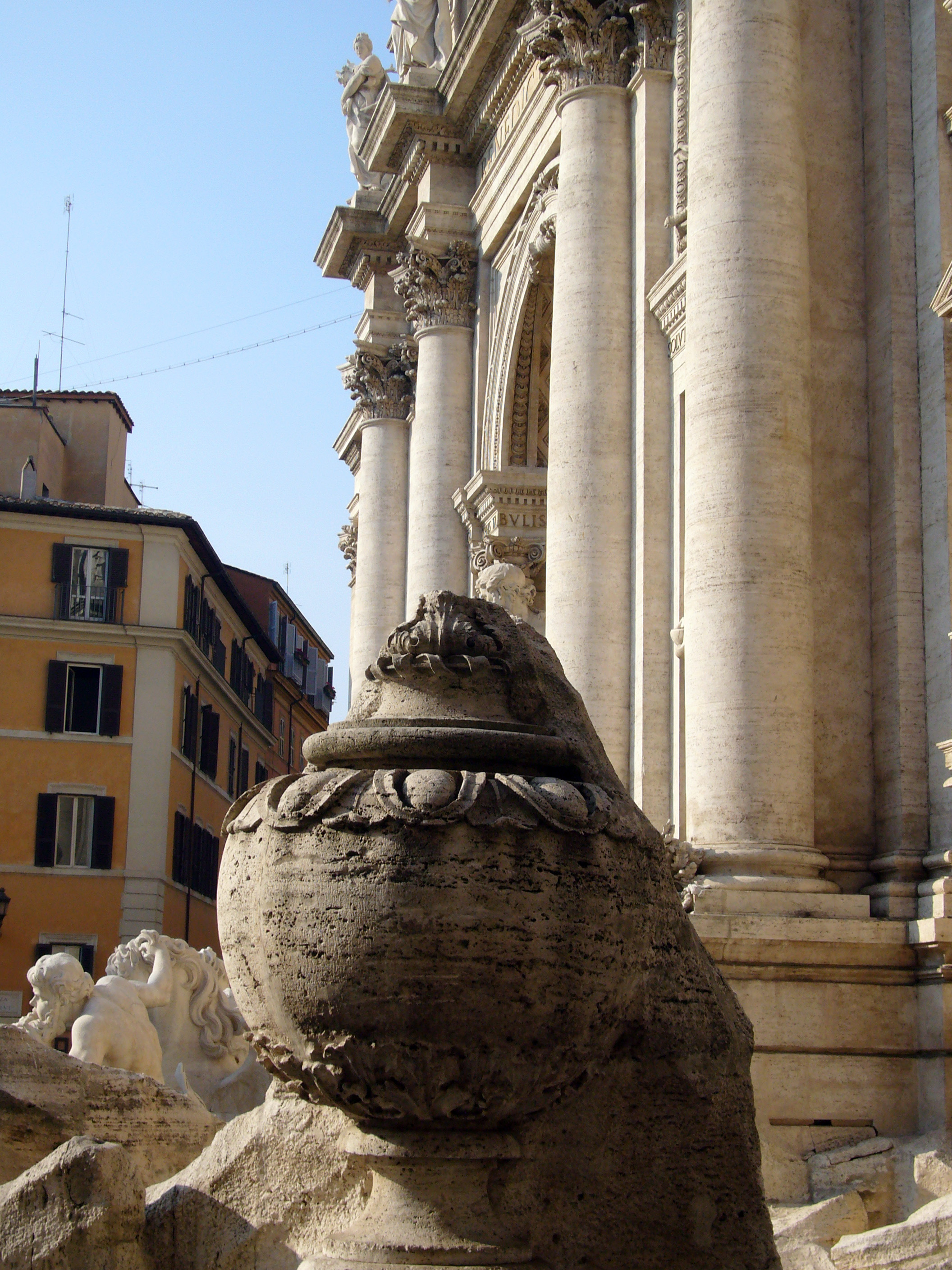 As the story goes, Salvi set up his work table in the middle of what is now the grand basin of the fountain. Like many projects of this scale, work could move very slowly and in the 18 years Salvi spend at this table he was subjected to all kinds of insults and criticism from the local inhabitants.
As the story goes, Salvi set up his work table in the middle of what is now the grand basin of the fountain. Like many projects of this scale, work could move very slowly and in the 18 years Salvi spend at this table he was subjected to all kinds of insults and criticism from the local inhabitants.
A barbershop on via della Stamperia annoyed him the most and after a while he was so fed up with them, he constructed a large Vase to hide them from his view. The Vase is still there. It’s the only ornamental piece along the fountain wall. The Romans refer to it as the Asso di Coppe (Ace of Spades).
The barber shop was replaced years ago. It’s currently a small leather bag souvenir shop at number 85 via della Stamperia.
In the 1869 Baedeker travel guide, it was written that if you took a sip of the water from the fountain you would surely return to Rome. Over the years however, prompted by fears of drinking foreign water, the sip was altered to tossing a coin.
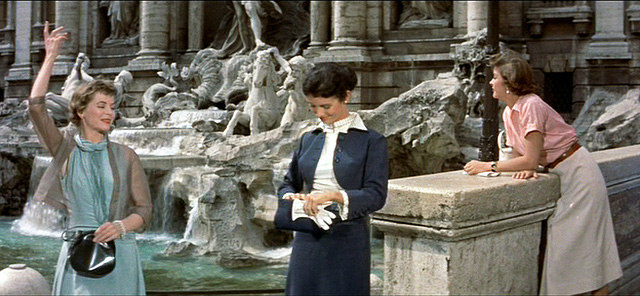 In the 1954 film, “Three Coins in the Fountain” the belief was changed to if you threw a coin into the fountain you would return to Rome. According to the film, the proper way of tossing the coin was to turn your back towards the fountain, place the coin into your right hand and throw it over your left shoulder. I have a feeling this tradition was invented by either the film’s Director, Jean Negulesco, or the screenwriter, John Patrick. These days people have all kinds of “lucky mannerisms” in their coin tossing.
In the 1954 film, “Three Coins in the Fountain” the belief was changed to if you threw a coin into the fountain you would return to Rome. According to the film, the proper way of tossing the coin was to turn your back towards the fountain, place the coin into your right hand and throw it over your left shoulder. I have a feeling this tradition was invented by either the film’s Director, Jean Negulesco, or the screenwriter, John Patrick. These days people have all kinds of “lucky mannerisms” in their coin tossing.
Over the years the superstition/tradition has evolved and now, two coins will grant you the marriage you long for. Three coins will grant the divorce.
Over the years, Trevi turned into a wishing well. People wish for all kinds of things. It’s estimated that between 3,000 and a day are thrown into the fountain. They are collected each day and donated to the Caritas Ambrosiana charity, used to help support housing projects and a supermarket for the poor people of Rome, that is, of course, if the money isn’t scooped out by thieves jumping into the fountain.
 In 2010, Roberto Cercelletta, going by the name d’Artagnan, stole in coins before getting arrested by the police. This was his second time being caught. He started collected the coins back in 1968 and has been arrested a number of times. Cercelletta’s defense was that if he wasn’t looting the fountain, someone else would be doing it. Cercelletta hasn’t been seen in the fountain since 2010. Maybe the fine for looting has gotten too steep for him. Maybe Italy has a 3 strikes rule. Maybe because he’s now 61 years old (2013) he just decided he had enough.
In 2010, Roberto Cercelletta, going by the name d’Artagnan, stole in coins before getting arrested by the police. This was his second time being caught. He started collected the coins back in 1968 and has been arrested a number of times. Cercelletta’s defense was that if he wasn’t looting the fountain, someone else would be doing it. Cercelletta hasn’t been seen in the fountain since 2010. Maybe the fine for looting has gotten too steep for him. Maybe Italy has a 3 strikes rule. Maybe because he’s now 61 years old (2013) he just decided he had enough.
But coins aren’t the only thing to get tossed into the fountain.
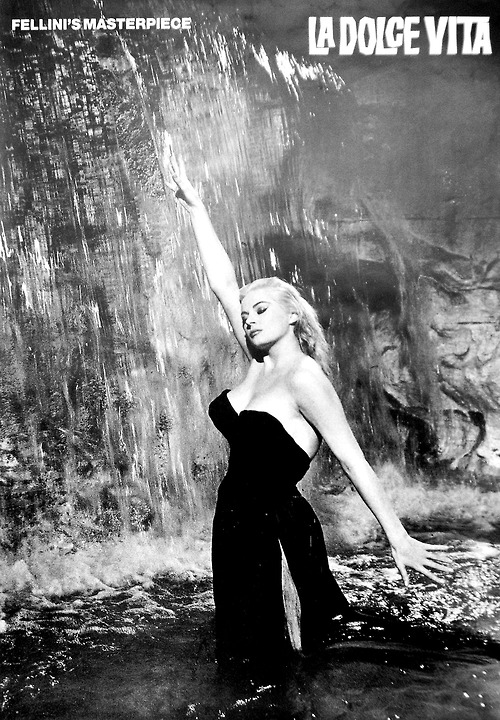 In 1960, Anita Ekberg jumped in for Fellini’s “La dolce Vita”. It was the high point of her career. After some well publicized romances with the likes of Tyrone Power, Frank Sinatra, Errol Flynn, Gary Cooper and Gianni Agnelli, she eventually faded away into her home near Rome. In 2011, she was released from a hospital in Rimini to discover her home was robbed and badly damaged in a fire. She is 82 years old, broke and destitute. She tried to get help from the Fellini Foundation, but without much luck. I wish some of the money collected from the fountain could be sent to her. Anita Ekberg has done more for the Trevi Fountain than anyone since Pope Clement XII. She waded into the icy waters in the middle of the winter and stood there for hours without complaining while her co-star Marcello Mastroianni, who also jumped in the fountain for the scene, wore a wetsuit under his clothes. I understand she could have handled her life differently and maybe she would not be in such financial trouble. But, wouldn’t it be a wonderful ending to this romantic story if the city of Rome made a donation to Anita Ekberg in thanks for making such a lasting contribution to the Trevi Fountain.
In 1960, Anita Ekberg jumped in for Fellini’s “La dolce Vita”. It was the high point of her career. After some well publicized romances with the likes of Tyrone Power, Frank Sinatra, Errol Flynn, Gary Cooper and Gianni Agnelli, she eventually faded away into her home near Rome. In 2011, she was released from a hospital in Rimini to discover her home was robbed and badly damaged in a fire. She is 82 years old, broke and destitute. She tried to get help from the Fellini Foundation, but without much luck. I wish some of the money collected from the fountain could be sent to her. Anita Ekberg has done more for the Trevi Fountain than anyone since Pope Clement XII. She waded into the icy waters in the middle of the winter and stood there for hours without complaining while her co-star Marcello Mastroianni, who also jumped in the fountain for the scene, wore a wetsuit under his clothes. I understand she could have handled her life differently and maybe she would not be in such financial trouble. But, wouldn’t it be a wonderful ending to this romantic story if the city of Rome made a donation to Anita Ekberg in thanks for making such a lasting contribution to the Trevi Fountain.
UPDATE: January 11, 2015, Anita Ekberg died in Rome at age 83. She had been in a hospital for a couple of weeks. She was wheelchair bound for several years after one of her pet Great Danes knocked her over and caused a broken hip. In an interview, Ekberg said she was not afraid of death. “I don’t know if paradise or hell exist,” she told Sweden’s Aftonbladet (Tabloid), “but I’m sure hell is more groovy.”
 In 1995, Claudia Schiffer repeated the pose of Anita Ekberg for a Valentino ad. The famous super model was brought in to the city to promote Valentino’s Rome based design house. For the next few days, Claudia would change into various Valentino creations while re-enacting scenes from the ‘La Dolce Vita’. The fashion shoot turned into a media frenzy, an unintentional coincidence of the original film where Sylvia (Anita Ekberg) was hounded by the paparazzi (a word also coined in the film). Throngs of people followed and screamed at Claudia as she moved from one location to another. As she moved down the narrow streets of the via Condotti, shopkeepers feared for the safety of their merchandise and plate glass windows and tried to prevent her from entering. After the film shoot, someone from the media contacted Anita Ekberg and asked her about the Claudia Schiffer shoot. Ms Ekberg told the interviewer, “Claudia Schiffer is nothing but a doll. She isn’t an actress. La Dolce Vita, that is me”.
In 1995, Claudia Schiffer repeated the pose of Anita Ekberg for a Valentino ad. The famous super model was brought in to the city to promote Valentino’s Rome based design house. For the next few days, Claudia would change into various Valentino creations while re-enacting scenes from the ‘La Dolce Vita’. The fashion shoot turned into a media frenzy, an unintentional coincidence of the original film where Sylvia (Anita Ekberg) was hounded by the paparazzi (a word also coined in the film). Throngs of people followed and screamed at Claudia as she moved from one location to another. As she moved down the narrow streets of the via Condotti, shopkeepers feared for the safety of their merchandise and plate glass windows and tried to prevent her from entering. After the film shoot, someone from the media contacted Anita Ekberg and asked her about the Claudia Schiffer shoot. Ms Ekberg told the interviewer, “Claudia Schiffer is nothing but a doll. She isn’t an actress. La Dolce Vita, that is me”.
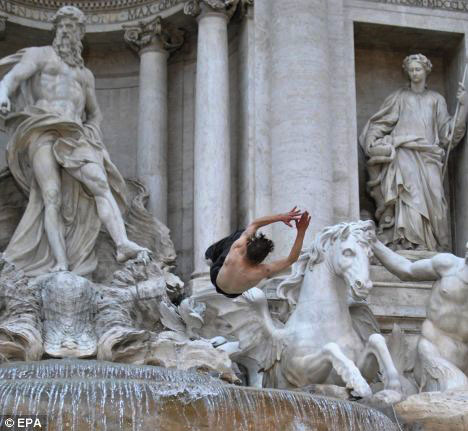 In 2010, a homeless drunk Romanian, known as Attila, entertained the tourists for about 30 minutes before he was removed by the police. As they carried him away, he shouted “I’ve had it with the world”. His fine was . One of the tourists watching the event remarked “he was very good. He performed some great flips and dives. He could do it for a living.
In 2010, a homeless drunk Romanian, known as Attila, entertained the tourists for about 30 minutes before he was removed by the police. As they carried him away, he shouted “I’ve had it with the world”. His fine was . One of the tourists watching the event remarked “he was very good. He performed some great flips and dives. He could do it for a living.
 In October, 2007, a Futuristic street artist named Graziano Cecchini poured red paint into the fountain. He was protesting the cost of the tickets to the Rome Film Festival, referring to the money spent on the Red Carpet. Cecchini, who was later apprehended by the police, said it wasn’t him, it was someone who looked like him.
In October, 2007, a Futuristic street artist named Graziano Cecchini poured red paint into the fountain. He was protesting the cost of the tickets to the Rome Film Festival, referring to the money spent on the Red Carpet. Cecchini, who was later apprehended by the police, said it wasn’t him, it was someone who looked like him.
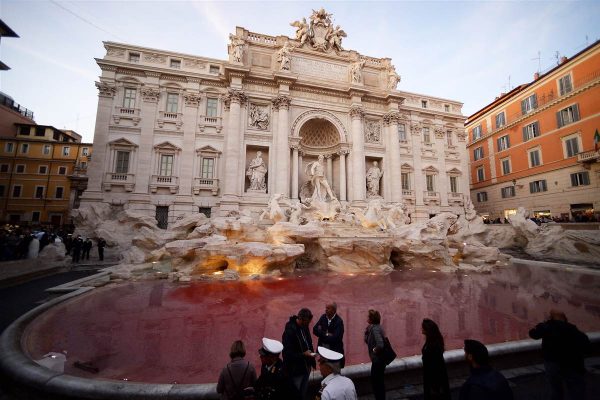 In October 2017, Graziano Cecchini was at it again. Ten years to the day of his first art attack, Cecchini was back with another bucket of red dye, claiming it a protest, a “cry that Rome isn’t dead, that it’s alive and ready to return to be the capital of art, life and Renaissance.” Needless to say, he was once again taken away to face charges of vandalism.
In October 2017, Graziano Cecchini was at it again. Ten years to the day of his first art attack, Cecchini was back with another bucket of red dye, claiming it a protest, a “cry that Rome isn’t dead, that it’s alive and ready to return to be the capital of art, life and Renaissance.” Needless to say, he was once again taken away to face charges of vandalism.
In 2007, Roberta, a 40 yr old office worker from Milan, stripped naked, swam into the fountain and sunbathed on the marble to the enjoyment of all the onlookers. She told the police. “the water belongs to everyone. I was hot.” She was fined for indecency and swimming in the fountain. Both are against the law in Rome.
In August 2012, workers from an Alcoa Aluminum Plant in Sardinia staged a protest at the fountain to protest the closing of the plant. Two of them jumped into the fountain.
In November 2012 a fake shark appeared in the fountain as a protest against the practice of finning, removing the fins of the Shark and leaving the rest of the animal to be eaten by predators or die of suffocation. The shark fin is the most valuable part of the shark.
There are always hundreds of people at the fountain snapping tourist shots. You would think with all these cameras clicking, there would be more photos of all the fountain invasions.
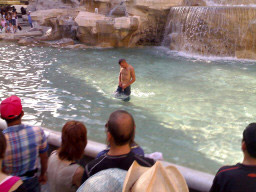
Keep it up all you photo journalists. Don’t just take photos of your selves at the Trevi Fountain. Wait a minute or two. There is a very good chance that something very unusual will happen. It’s thanks to all of you that I can find many of these wonderful photos.
One more note on the Trevi Fountain. All the fountains of Rome (unless noted) provide drinkable water to anyone who wishes to fill up their bottles or bags or hands. Free water has been one of the wonders of Rome since the Roman Republic. Even though there are no visible posting of “non potabile” around the Trevi Fountain, I’d strongly advise against drinking it. Since 1999, the Roman Water Utility (ACEA S.p.A) has tried to figure out ways to keep the water of the fountain clean and beautiful to look at. This has included large doses of anti-calcium, anti –fungus, antibiotics and anti-foliants. Drink if you wish but be prepared. There is most likely another water fountain (nasone) a few yards down the road. The “nasone”, large nose in Italian, run all the time from fresh mountain stream water. It is cold and very refreshing on a hot day.
ADDENDUM:
After 17 months under wraps, the Trevi Fountain reopened in November 2015. In January 2013, the Rome fashion house, Fendi, announced they were providing million (euros) for the restoration. The fountain hasn’t had a major renovation since it’s completion date in 1751. During the renovation, the basin was drained of water but the Fendi organization wanted to keep the tradition of tossing coins into the fountain and so they created a small pool for tourists to toss a coin in exchange for a wish.
Fashion houses have been responsible for many of the ‘much needed’ restorations in the city. The Tod’s Luxury Leather Company gave million euros to restore the Coliseum. The Yagi Tshusho Company (Montcler) gave million euro for the restoration of the 1st century BC Pyramid of Cestius and the Bulgari Fashion House is providing million euros to restore the Spanish Steps. Recently Telecom Italia gave million euros for the restoration of the Mausoleum of Augustus. The project will hopefully be completed by April 2017.
July 19, 2016
Delilah Jay, author of a book, “Mistress – The Italian Way”, and former model, posed topless for the German tabloid Bild. At the age of 52, she decided to imitate Anita Ekberg’s plunge into the Fountain on a hot afternoon. She straddled the rim of the basin in evening clothes, blew kisses to the crowd and was then escorted away by the polizia. She later paid a fine of €450 euros.
April 13, 2017
 A 30 something year old Italian man removed his clothes and placed them on the side of the fountain. Then, as a large crowd watched, he jumped naked into the fountain, exhibiting his breast stroke to the stunned and sunned visitors.
A 30 something year old Italian man removed his clothes and placed them on the side of the fountain. Then, as a large crowd watched, he jumped naked into the fountain, exhibiting his breast stroke to the stunned and sunned visitors.
The swimmer pulled himself from the fountain where police were waiting for him. They covered him up and walked him over to a police car and drove him away.
These days when anyone does something like this it is usually captured on a smartphone. This act of disrespect was no different. Here is the video.
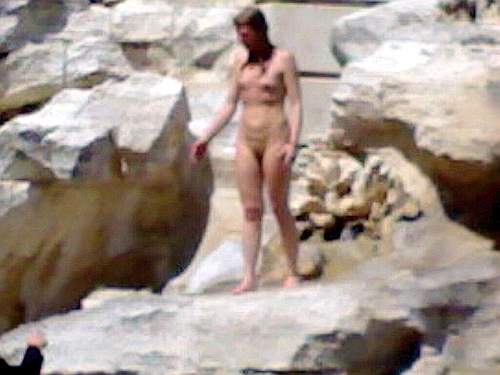
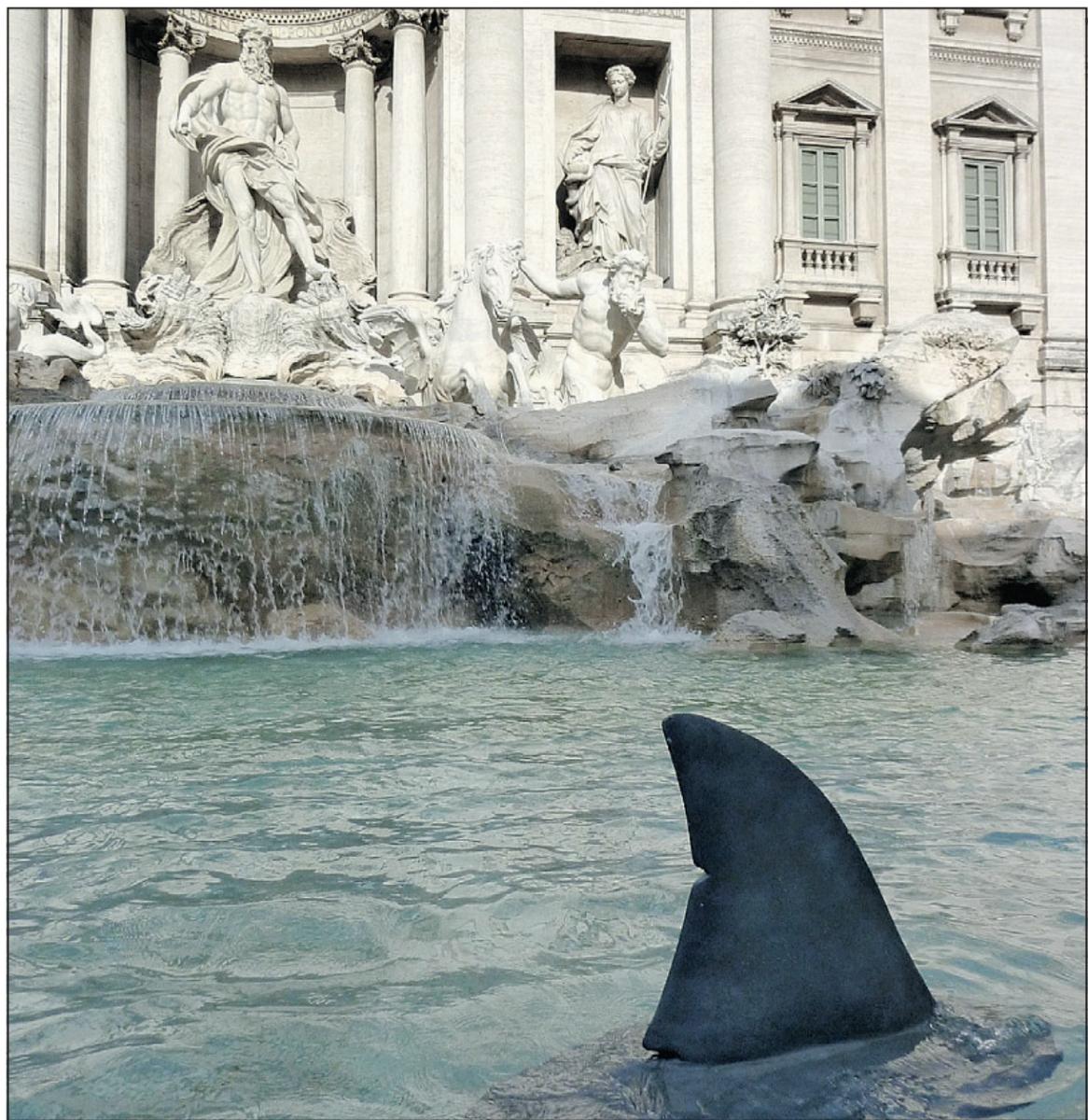

You must be logged in to post a comment.